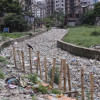Building Approval Thru' Forged Signatures: Architects question Rajuk's silence

For four years, Rajuk has been silent on reported incidents of building approvals with forged signatures of the architects concerned, said the president of Institute of Architects Bangladesh (IAB) at a press conference yesterday.
The IAB over the years discovered around 2,000 incidents in which the signatures of architects were forged. It had written to the Rajdhani Unnayan Kartripakkha (Rajuk) seeking legal action against the buildings and urged the Rajuk to declare that those buildings had obtained approvals through forgeries, said IAB President Jalal Ahmed.
For example, architect Mehedi Amin yesterday complained that a nine-storey building was being constructed on Road-13 of Baridhara's Block-K, naming him as the architect. But he had not signed off on the building design.
Jalal said the incidents of forgeries were discovered when architects went through Rajuk's official website that had the list of Rajuk approved buildings with their addresses, owners' name, and the architects' names.
At least half a dozen aggrieved architects even filed general diaries with police as they saw building designs they had not endorsed were approved by Rajuk using their names.
The Rajuk stopped uploading the list of approved building on its website about three years ago, Jalal said.
“Meanwhile, building approval with forged signatures of architects has become rampant not only in the capital but also across the country, rising to the number of risky buildings,” he said.
The Daily Star tried to contact Rajuk Chairman Md Abdur Rahman for his comments but he did not pick up his phone nor reply to the text messages.
The IAB organised the press conference on “fire safety and safeguard of lives at buildings” at the IAB Centre yesterday in the wake of the devastating fire at FR Tower in Banani that left 27 people dead.
Jalal, reading out a statement of his organisation, said after the fire, the government authorities suddenly started doing the routine work they were supposed to be doing all these years, checking safety measures at buildings.
Architect Iqbal Habib said the officials whose sloppiness led to building disasters were now checking building safety.
The IAB in the statement said the building rules made in 1984 and 1996 lacked the vision for Dhaka's rapid urbanisation, with changes to physical, infrastructural, environmental, and cultural landscape.
For example, the 1984 rules lacked provision for leaving open space on two sides of a building. It made emergency exits mandatory only in buildings taller than seven storeys.
The 2006 rules for the first time made it mandatory to have measures for fire safety, environmental conservation, and universal access to a building, the IAB said.
Apart from the building rules and the national building code, fire safety is also enforced by the fire department. A building over 10 storeys needs approval from the fire and electricity departments, the IAB said, adding that sloppy electrical design is considered the foremost reason behind fires.
The laws of multiple authorities are often conflicting and greedy quarters take advantage of this and make unsafe buildings, it said.
To ensure coordination among authorities, the 2006 rules had provision for a “One Window Cell” comprising representatives of all authorities. But it had to be scrapped in the face of opposition by some vested quarters, the IAB said.
The 2006 building rules made occupancy certificates, given after inspection, mandatory for newly constructed buildings to get water, electricity, and gas connections. Only 165 building owners obtained the certificates.
In 2008, the strict rule regarding occupancy certificates was relaxed, allowing buildings to be constructed in deviation of approved design.
The Nagar Unnayan Committee, made to ensure accountability in building construction, has been ineffective for the last two years, the IAB claimed.
Even though the building rules were updated, structures continued to be made deviating from the approved plans due to slack monitoring and poor enforcement of laws by the authorities, it said.
IAB RECOMMENDATIONS
As short-term measures, the IAB recommended retrofitting buildings to reduce fire risks, approving the updated national building code and enforcing it, making building occupancy certificates mandatory again, and enhancing Rajuk's regulatory role.
Better training of inspectors, fire safety officials, and firemen, and ending corruption in agencies responsible for fire safety were mentioned as long-term recommendations.
Former IAB president Mubasshar Hussain, among other IAB office bearers, was present while its Vice-President Mamnoon Murshed Chowdhury conducted the press conference.

 For all latest news, follow The Daily Star's Google News channel.
For all latest news, follow The Daily Star's Google News channel. 







Comments